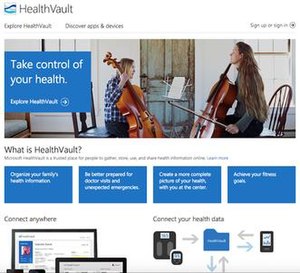Microsoft HealthVault
 | |
 Microsoft HealthVault website | |
| Developer(s) | Microsoft |
|---|---|
| Initial release | 2007 |
| Type | Personal health record |
| Website | healthvault |
Microsoft HealthVault (2007–2019) was a web-based personal health record created by Microsoft, in October 2007, to store and maintain health and fitness information.[1][2][3][4] This website was for use by both individuals and healthcare professionals, and in June 2010, it expanded its services beyond the United States to include the United Kingdom.[5]
On April 5, 2019, Microsoft announced that effective November 20, 2019, HealthVault would be closed,[6] any data left in user accounts would be deleted, and any apps dependent on HealthVault for data would also stop working.[7][8]
Components[]
A HealthVault record stored an individual's health information. Access to a record was through a HealthVault account, which may have been authorized to access records for multiple individuals, e.g., so that a parent could manage records for their children, or a child could access their parent's records to help the parent deal with medical issues. Authorization of the account could initially be performed with the use of a Facebook account, Windows Live ID account, or an account from a limited set of other OpenID providers, but on April 6, 2016, Microsoft announced via email to users that Facebook and OpenID sign-in would not be available after 31 May 2016.[9] After this time, when attempting to log in using these methods, a page indicating they were no longer supported was displayed.[10]
Authorization[]
This section does not cite any sources. (January 2016) |
An individual interacted with their HealthVault record through either the HealthVault website or, more typically,[citation needed] through an app, application, or device that communicated with the HealthVault platform. When an individual first used a HealthVault application, they were asked to authorize the application to access a specific set of data types, and those data types were the only ones the application could use. An individual could also share either their entire health record or selected data with another interested individual, such as a doctor, relative, etc.[11]
Devices[]
HealthVault Connection Center allowed health and fitness data to be exchanged between selected devices (such as blood pressure monitors, heart rate watches, and the Withings WiFi bodyscale) into an individual's HealthVault record. It was also usable to find and download drivers for medical devices.[12][13] Additionally, in 2014, Microsoft introduced the Microsoft Band, a fitness band powered by the Microsoft Health service that supported the Microsoft HealthVault for aggregation and integration of various services, such as MyFitnessPal.[14][15]
Medical imaging[]
This section does not cite any sources. (January 2016) |
HealthVault supported storage, viewing, uploading, and downloading, by consumers and third parties, of DICOM based medical imaging. Additionally, a plethora of third party HealthVault medical imaging viewers had been released to connect to HealthVault.
Interoperability[]
HealthVault supported a number of exchange formats, including industry standards such as the Continuity of Care Document and the Continuity of Care Record. Support for industry standards made it possible to integrate[16] with many personal health record solutions.
See also[]
References[]
- ^ Hachman, Mark (2007-10-04). "MicrosoftLaunches 'HealthVault' Records-Storage Site". PCMag. Retrieved 2008-02-04.
- ^ "Microsoft launches medical records site". The Globe and Mail. Toronto. Retrieved 2008-02-04.
- ^ "The vault is open". The Economist. 2007-10-04. Retrieved 2008-02-06.
- ^ "Microsoft Launches Health Records Site". Fox News. 4 October 2007.
- ^ Hoeksma, Jon (2010-06-23). "Microsoft launches HealthVault in UK". E-Health Insider. Archived from the original on 2013-03-16. Retrieved 2013-10-16.
Microsoft has launched its personal health record platform in the UK
- ^ "Microsoft to Retire Its Health Service in November". Softpedia. April 8, 2019. Retrieved April 9, 2019.
- ^ Foley, Mary Jo for All About Microsoft (April 5, 2019). "Microsoft is closing its HealthVault patient-records service on November 20". ZDNet.CS1 maint: uses authors parameter (link) "Microsoft is suggesting users who want to transfer or export their data to another personal health record provider contact Get Real Health (U.S. and international customers) and/or FollowMyHealth (U.S. customers only)."
- ^ Thorp-Lancaster, Dan (5 April 2019). "DOWN IT GOES: Microsoft HealthVault service shutting down on November 20. Any data left in HealthVault accounts will be deleted on November 20". WindowsCentral.
- ^ "Unable to access records from Facebook sign-in". social.technet.microsoft.com. Retrieved 2018-02-25.
- ^ "Status - HealthVault". account.healthvault-ppe.com. Retrieved 2018-02-25.
- ^ "FollowMyHealth | Microsoft HealthVault Users Can Now Transfer Their Health Data To Allscripts' Patient Platform". Retrieved 2020-11-03.
- ^ "Dr. Microsoft is now ready to see you". istartedsomething.com. Retrieved 2007-10-08.
- ^ "What Is Connection Center?". HealthVault. Archived from the original on 2007-10-11. Retrieved 2007-10-08.
- ^ Sullivan, Mark (4 November 2014). "With the launch of the Microsoft Band, HealthVault moves behind the scenes". VentureBeat.
- ^ Lein, Adam Z. (3 November 2014). "How many different health platforms does Microsoft need?". PocketNow.
- ^ "Community: PHR integration". Records For Living. Retrieved 2009-02-09.
External links[]
- Official website at Healthvault.com
- "HealthVault". msdn.microsoft.com/HealthVault. Microsoft Developer Center.
- "FollowMyHealth". FollowMyHealth.com. Allscripts.
- "Lydia Get Real Health". getrealhealth.com. Get Real Health (a CPSI company).
- Electronic health record software
- Microsoft software
- Internet properties established in 2007
- Telehealth
- American health websites
- Discontinued Microsoft products